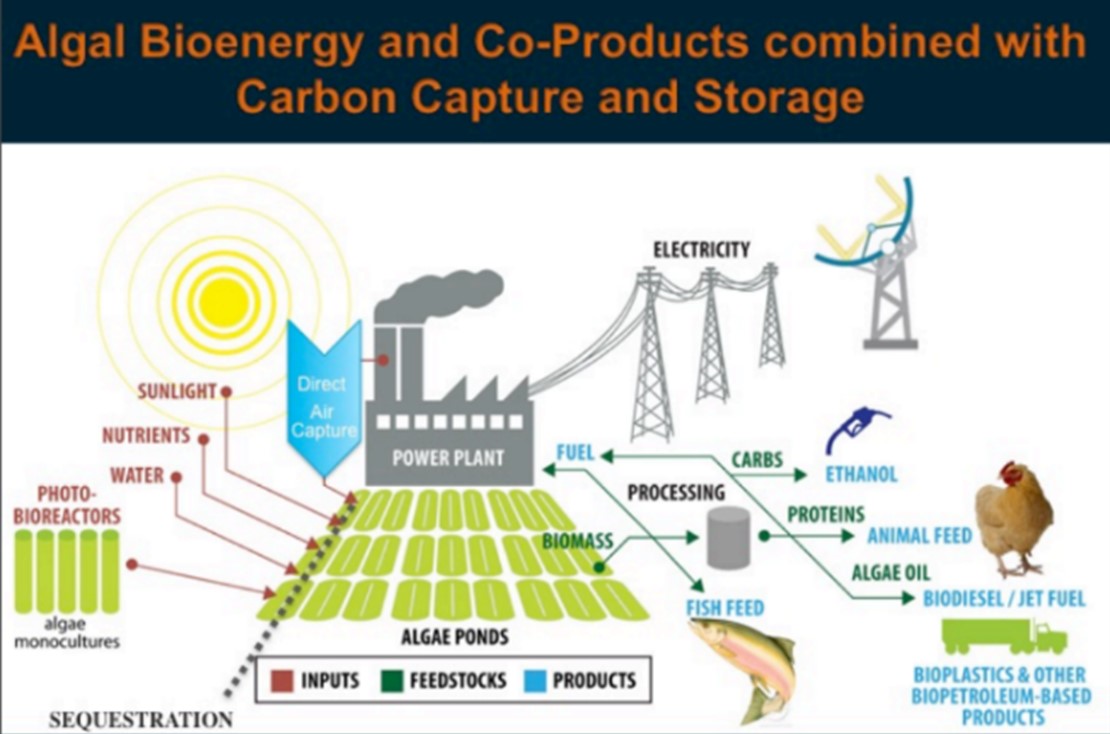CARBON CAPTURE BY ALGAE
INTRODUCTION
- Concentration increase in C02 in the atmosphere leads to changes in climate.
- The production, decomposition, and accumulation of biomass play a crucial role in the global carbon cycle.
- Carbon capture from photosynthesis, carbon deposition in the soil and oceans, and carbon release from biological and geological sources should be in equilibrium for the maintenance of a well-balanced ecosystem.
- Due to carbon emissions from the combustion of fossil fuel and biomass, and reduced carbon uptake as a result of global deforestation and the loss of arable land this equilibrium has been disturbed.
- The environmentally sustainable way to reduce greenhouse gas emissions associated with energy production is to generate energy from carbon-neutral or reduced-carbon-emission sources.
- Biomass products can be converted into energy-dense, liquid-storage fuels.
- There are several reasons for the greater biomass yields of algae versus land plants.
- Advantages of microalgae-based biofuels are
- greater production yields and
- available land area (compared with terrestrial crops)
- algae’s ability to capture CO2 as bicarbonate in ponds,
- reducing atmospheric CO2 emissions;
- and reduced competition for land, particularly arable land used for food production.
CARBON CAPTURE BY ALGAE
- Aquatic carbon capture and biomass production systems have the ability to capture CO2 in ponds in a nongaseous form as bicarbonate to fertilize the algal growth.
- The dominant form of CO2 in water is bicarbonate given at moderate pH and temperature (below 30 degrees).
- Algae can concentrate bicarbonate in the cell due to the presence of active bicarbonate pumps within them.
- The bicarbonate is dehydrated by carbonic anhydrase. This results in the capture of CO2 through Calvin-cycle
- Its ultimate form is algal biomass.
- 6 – 2 grams of CO2 are captured for every gram of algal biomass produced.
- Industrial sources of CO2 can be harvested using algal ponds.
- The injection of power plant flue gases (have high CO2 concentrations, ranging from 10% to 20%) into algal ponds upgrades algal biomass yields by three times.
- The efficiency of CO2 capture by algae vary according to the state of the algal physiology, pond chemistry, and temperature.
- Carbon-dioxide capture efficiencies as high as 80% to 99% are achievable by the production of algal biomass under optimal conditions.
- An algal pond of 3600 acres would be sufficient to capture 80% of the plant’s CO2 emissions during daylight hours with a biomass productivity rate of 20 grams dry weight per square meter per day.
- Locating algal ponds near CO2 point sources gives several potential costs- and energy-saving advantages.
- Integrated power plant–algal pond facilities:
- reduce the costs of CO2 transportation
- produce limited waste heat from the power plant for warming ponds in the winter
- The major drawback is CO2 capture by biomass production is not workable in the dark.

CARBON SEQUESTRATION BY ALGAE
- CO2 must be isolated over long-time intervals to have the greatest impact on greenhouse gas accumulation.
- A lower risk strategy for mitigating carbon dioxide is to chemically convert CO2 into stable liquids or solids.
- Another strategy for isolating carbon is to bury it as biomass.
- Permanent burial of total algal biomass in deep geologic formations and burial of extracted or processed carbon-rich fractions from algal biomass are the two possible algal carbon isolating systems.
- The drawback of the direct burial of total algal biomass is that inorganic nutrients would also be buried with the algal biomass. Burying of inorganic elements is not sustainable.
- Burying only the neutral lipid or hydrocarbon fraction of the algal biomass is an alternative approach.
- More than 75% of the mass of neutral lipids (TAG) is carbon, TAGs represent rich sources of captured carbon in cells.
- Triacylglycerols extraction can be injected into geologic formations to seal the carbon in place.
- TAGs do not contain elements other than carbon, hydrogen, and oxygen so the inorganic nutrients which are required for algal growth can be recycled and not buried with the carbon.

SUMMARY
- Laboratory studies suggest that carbon capture by algae is a viable strategy for mitigating CO2 emissions from anthropogenic sources.
- Life-cycle analyses suggest the costs for capturing carbon and producing liquid biofuels from algae may approach the costs of producing petroleum-based fuels in the next 5 to 10 years
REFERENCES
- https://www.academia.edu/24476609/Carbon_Capture_and_Sequestration_using_Microalgae
- https://academic.oup.com/bioscience/article/60/9/722/238034
- https://www.frontiersin.org/articles/10.3389/fmars.2019.00029/full